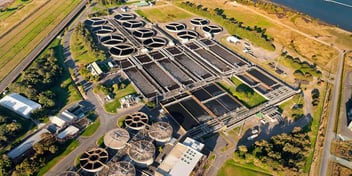Queensland wastewater treatment receives boost from bacteria
Marking an Australian first for wastewater treatment, Queensland’s Urban Utilities has partnered with Veolia to implement an anammox sidestream plant at its Luggage Point site, which is expected to deliver treatment cost savings of up to $500,000 per year.
Supplied by Veolia, the Anita Mox technology provides a carrier for anammox, a bacteria that treats wastewater with up to 60% less air and no additional chemicals when replacing conventional treatment options for nitrogen removal — resulting in considerable energy and operational savings.
The technology has also allowed Urban Utilities to upgrade existing tanks on site to become Anita Mox process tanks, removing the need to build additional infrastructure.
With Brisbane’s population growing, Urban Utilities Project Engineer Justin Todhunter said it’s essential for the utility to expand upon existing wastewater treatment capacity.
“Luggage Point is Urban Utilities’ largest treatment plant, treating about 60% of Brisbane’s sewage. As cities grow, they produce more wastewater and treatment plants need to grow in order to continue to provide those services,” Todhunter said.
“And also to meet our environmental requirements to protect the receiving waterways, which is one of our primary roles.
“With the increasing sewage load coming to the treatment plant, we’ve sought to address that through adding additional capacity via the anammox process. It adds additional capacity to our treatment plant to enable us to continue to service the community.”
Cost-effective and flexible
Todhunter said that while there are many options available in terms of increasing treatment capacity, Urban Utilities settled on Veolia’s solution due to the reduction in operating costs the technology enables, as well asthe flexibility it provides the utility in terms of managing effluent.
“Anammox was selected because it has an additional benefit of using less energy and chemicals, which reduces our operating costs of the treatment plant itself. This in turn helps keep downward pressure on the cost to serve our customers,” he said.
“Anammox operates a bit differently to conventional treatment processes in that it is able to shortcut the bacterial treatment process to remove nitrogen from the wastewater and therefore doesn't require the same amount of energy or chemicals. It was selected because it can do more with less.
“It also offers more flexibility in terms of refining effluent from the plant. This provides better outcomes for our environment, which is particularly important for the Luggage Point location — we are situated next to Moreton Bay, a marine park providing habitat for flora and fauna.”
Aside from the benefits the technology provides for customers and the environment, Todhunter said using Anita Mox reduces the high-cost associated with civil works, which are often required when increasing the capacity of treatment plants.
“Civil work, especially at Luggage Point, can be expensive, particularly as it’s on reclaimed land; however, Anita Mox allows us to retrofit assets onsite, which is ideal,” he said.
A model for other plants
Completion of installation is expected this year, and Todhunter said one of the most exciting outcomes is the ability Urban Utilities and Veolia will have to help other Australian wastewater treatment plants to use the technology too.
“Biosecurity laws prohibit anammox from being transported into Australia. This is why we started the journey of cultivating it. But, once we are fully operational, the anammox sidestream plant will act as a biofarm,” he said.
“Once we have large quantities of biomass, we will then be able to act as a biofarm for the rest of Australia. This means that Urban Utilities, along with Veolia, can assist other wastewater utilities with the same technology, and to receive the same benefits that we are hoping to achieve with the implementation of this new technology.”
Todhunter said the journey towards harnessing the benefits of anammox has been made possible by the utility’s Innovation Centre, which is a platform that allows Urban Utilities to partner up with different technology providers and universities.
“We are pursuing these new technologies because they allow us to provide a better service at the best possible cost we can achieve, which, in the end, transfers directly to our customers,” he said.
“Our Innovation Centre helps us keep track of all the technology opportunities available, so we can improve on how we operate. As part of the process, we have brought a lot of the staff on board during the early stages.
“By involving our operators early on, they’ve become confident with the technology, enabling us to ensure successful implementation. It also provides the confidence that our team will be able to continue to look for and implement other new technologies in future, too.”


